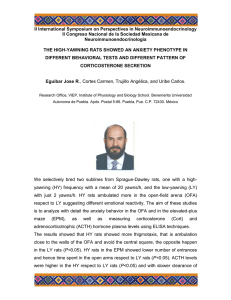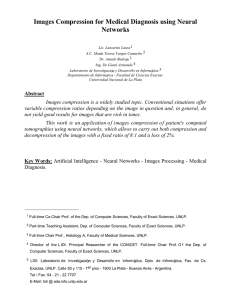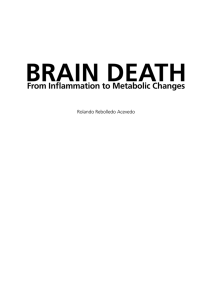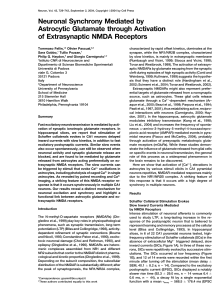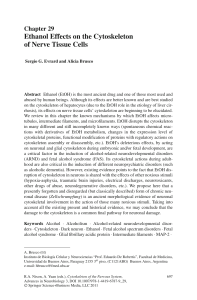Experimental change on dopaminergic neurons in striatum of
Anuncio
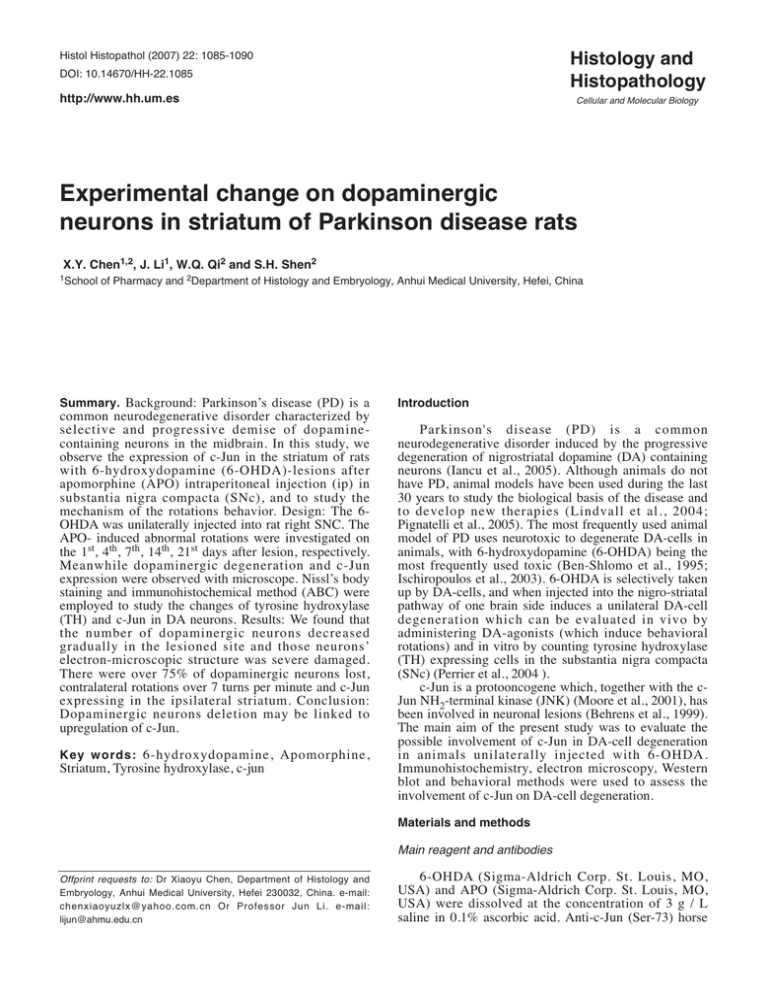
Histology and Histopathology Histol Histopathol (2007) 22: 1085-1090 DOI: 10.14670/HH-22.1085 http://www.hh.um.es Cellular and Molecular Biology Experimental change on dopaminergic neurons in striatum of Parkinson disease rats X.Y. Chen1,2, J. Li1, W.Q. Qi2 and S.H. Shen2 1School of Pharmacy and 2Department of Histology and Embryology, Anhui Medical University, Hefei, China Summary. Background: Parkinson’s disease (PD) is a common neurodegenerative disorder characterized by selective and progressive demise of dopaminecontaining neurons in the midbrain. In this study, we observe the expression of c-Jun in the striatum of rats with 6-hydroxydopamine (6-OHDA)-lesions after apomorphine (APO) intraperitoneal injection (ip) in substantia nigra compacta (SNc), and to study the mechanism of the rotations behavior. Design: The 6OHDA was unilaterally injected into rat right SNC. The APO- induced abnormal rotations were investigated on the 1st, 4th, 7th, 14th, 21st days after lesion, respectively. Meanwhile dopaminergic degeneration and c-Jun expression were observed with microscope. Nissl’s body staining and immunohistochemical method (ABC) were employed to study the changes of tyrosine hydroxylase (TH) and c-Jun in DA neurons. Results: We found that the number of dopaminergic neurons decreased gradually in the lesioned site and those neurons’ electron-microscopic structure was severe damaged. There were over 75% of dopaminergic neurons lost, contralateral rotations over 7 turns per minute and c-Jun expressing in the ipsilateral striatum. Conclusion: Dopaminergic neurons deletion may be linked to upregulation of c-Jun. Key words: 6-hydroxydopamine, Apomorphine, Striatum, Tyrosine hydroxylase, c-jun Introduction Parkinson's disease (PD) is a common neurodegenerative disorder induced by the progressive degeneration of nigrostriatal dopamine (DA) containing neurons (Iancu et al., 2005). Although animals do not have PD, animal models have been used during the last 30 years to study the biological basis of the disease and to develop new therapies (Lindvall et al., 2004; Pignatelli et al., 2005). The most frequently used animal model of PD uses neurotoxic to degenerate DA-cells in animals, with 6-hydroxydopamine (6-OHDA) being the most frequently used toxic (Ben-Shlomo et al., 1995; Ischiropoulos et al., 2003). 6-OHDA is selectively taken up by DA-cells, and when injected into the nigro-striatal pathway of one brain side induces a unilateral DA-cell degeneration which can be evaluated in vivo by administering DA-agonists (which induce behavioral rotations) and in vitro by counting tyrosine hydroxylase (TH) expressing cells in the substantia nigra compacta (SNc) (Perrier et al., 2004 ). c-Jun is a protooncogene which, together with the cJun NH2-terminal kinase (JNK) (Moore et al., 2001), has been involved in neuronal lesions (Behrens et al., 1999). The main aim of the present study was to evaluate the possible involvement of c-Jun in DA-cell degeneration in animals unilaterally injected with 6-OHDA. Immunohistochemistry, electron microscopy, Western blot and behavioral methods were used to assess the involvement of c-Jun on DA-cell degeneration. Materials and methods Offprint requests to: Dr Xiaoyu Chen, Department of Histology and Embryology, Anhui Medical University, Hefei 230032, China. e-mail: chenxiaoyuzlx@yahoo.com.cn Or Professor Jun Li. e-mail: lijun@ahmu.edu.cn Main reagent and antibodies 6-OHDA (Sigma-Aldrich Corp. St. Louis, MO, USA) and APO (Sigma-Aldrich Corp. St. Louis, MO, USA) were dissolved at the concentration of 3 g / L saline in 0.1% ascorbic acid. Anti-c-Jun (Ser-73) horse 1086 Dopaminergic neurons in Parkinson disease monoclonal antibody and anti-tyrosine hydroxylase (TH) horse monoclonal antibody were purchased from Sigma, USA. SABC, DAB were purchased from Beijing Zhongshan Golden Bridge Biotechnology Co., Ltd., China. rotometer (Tokyo Narishige instrument lab, Japan) after injection with APO (0.5 mg/Kg). They were allowed to acclimatise to their environment for 10 min before turns contralateral and ipsilateral to the lesion were recorded over 30 min (Rothblat et al., 2001). Male Sprague-Dawley rats, 220-250 g, were obtained from the Animal facility of Anhui Medical University (Hefei, China). The rats were kept in a colony room with an environmental temperature of 22°C, a 12 h light-dark cycle (7:00 am onset) and free access to both water and food. The experiments were carried out in strict accordance with the Guide of the National Institute Health for the Care and Use of Laboratory Animals and the Animal Care and Use Committee of Anhui Medical University approved all the methods used in this study. Two hours after the behaviour test, animals were deeply anaesthetized with sodium pentobarbital (300 mg/kg, ip.) and perfused intracardially with 100 ml heparinized saline followed by 200 ml 4% paraformaldehyde in 0.1 M PBS (ph 7.4). For ultrastructure study, fresh brain tissue was rapidly frozen by contact with an aluminium plate and stored at -70°C. The substantia nigra and corpus striatum was identified, dissected, and samples placed directly into a cold (4°C) solution of 0.1% glutaraldehyde (vacuum-distilled) in phosphate buffered saline (PBS). The following procedures were carried out at 4°C. After 18 h of fixation, the samples were rinsed thoroughly in PBS then dehydrated in an ethanol series and embedded in resin. Serial thin sections were collected onto formvarcoated transmission electron microscopy (TEM) support grids and immunogold labelled using an established methodology (Beaman, 1993). Thin sections were examined in Olympus (Japan) J-1230 TEM at 100 kV. For histochemistry study, after postfixation with 4% paraformaldehyde for 24 h and equilibration in 20% sucrose in 0.1 M PBS (ph 7.4) for cryoprotection, six series of coronal sections were cut at 40 µm thickness on a freezing microtome. DA-cell damage was tested with Nissl staining, immunohistochemistry avidin-biotin complex (ABC) methods (biotinylated horse anti-mouse IgG 1:200 dilution -Beijing Zhongshan Golden Bridge Biotechnology Co., Ltd., China, ABC kit -Beijing Zhongshan Golden Bridge Biotechnology Co., Ltd., China-, DAB reagents). Sections were analyzed with the JieDa 801 Pathology Image Analysis System (made in the Nanjing University, China) and neuron damage was assessed according to the following formula: 100- (Right-sidedness cell number / Left- sidedness cell number) x 100 For c-Jun protein analysis, these brain samples were frozen on the dry ice-cooled isopentane and stored immediately in liquid nitrogen until use (Henderson et al., 2003). Animals Animal grouping After one week of acclimatization, the rats were tested with APO and those showing no rotation behavior were randomly divided into three groups: untreated group (NC, n=8), saline infusion sham lesion group (NS, n=8), and 6-OHDA infusion lesioned groups (n=40). 6-OHDA damage surgical procedures Following previous studies (Borlongan et al., 1995; Dauer et al., 2003), the rats anaesthetized with pentobarbital (40 mg/Kg) were fixed on a stereotaxic apparatus and injected (1 µl/min) in the left SNc (coordinates: A: -5.3 mm from bregma, L: +1.8 mm from midline and H: -7.8 mm from dura; Paxinos Watson’s “Rat Brain Solid Localization Card) with 6OHDA (8 µg of 6-OHDA in 4 µl of 0.2 % ascorbic acid saline solution; pH 7.2). After the injection, the needle was kept in place for 15 min to allow for diffusion of the toxin away from the injection site and to prevent backflow. Control rats received sham vehicle (0.2% ascorbic acid saline solution; ph 7.2)) infusion. Gentamycin sulfate (5 mg/Kg) was injected into muscle to prevent infection. Normal control group were only fed in the cage (Hudson et al., 1993). Behavioral studies The rats’ ability to rotate in response to APO (0.05 mg/Kg subcutaneously, s.c.) was measured at 8 Am on the1 st, 4 th, 7 th, 14 th, 21 st days after injection. Thirty minutes before the rotation test, each rat was placed in a rodent residence. Contralateral rotations induced by APO were measured once a week for 3 weeks. Only those rats showing at least 210 turns during the 30min test (unilateral 6-OHDA lesioned rats) were selected for further study. The rats in these groups were placed in individual glass bowls with a diameter of 20 cm and attached via a specially adapted harness to an automated Morphologic observation c-Jun protein analysis Tissue from the left and right striatum and substantia nigra was dissected separately 1 week after injection and frozen immediately. The tissue samples were mechanically homogenized in lysis buffer containing leupeptin, aprotinin, and PMSF. After 1000 g centrifugation for 10 min, Laemmli's buffer was added, and 20 µg protein of each sample was used for SDSPAGE, followed by electroblotting to nitrocellulose membranes. A rat polyclonal phosphospecific anti-c-Jun 1087 Dopaminergic neurons in Parkinson disease antibody (1:1000 dilution; Sigma) and mouse monoclonal anti-ß-actin (1:500 dilution; Sigma) were incubated at 4°C overnight. After washing with TBS-T (10 mM Tris-HCl (ph 7.4), 0.9% NaCl, 0.05%, Tween20), the blots were incubated with horseradish peroxidase-conjugated secondary antibodies [biotinylated horse anti-mouse IgG (1:200, Beijing Zhongshan Golden Bridge Biotechnology Co., Ltd., China.)] and visualized using the Amersham enhanced chemiluminescence ECL system. The same experiments were repeated at least three times for each condition. Statistical method Statistical analyses were performed using SPSS 11.5 software. Data were expressed as mean ± standard error, and compared by the means of one-way ANOVA between different groups and the LSD-t as a method in each group. In all analyses, P<0.05 was considered statistically significant between groups. Results APO Inducing Rotation Experiment As shown in table 1, APO induced rotations 7 days after 6-OHDA administration, an effect which increased (see rotation circles and velocity) on days 14 and 21 post-lesion. Rotating speed (≥ 7 turns per minute) reached the standard of PD model on the 14th day and no rotation behavior appeared in other groups. Morphologic result As indicated in Figure 1, Nissl staining showed tumid cells in the lesioned SNc. The number of the TH positive (TH + ) neurons showed a marked and progressive decrease (Fig. 2 and Table 2 ). 21 days after 6-OHDA injection, the electron microscopy photomicrograph showed a tumid chondriosome, rough endoplasmic reticulum, Golgi body and the disappearance of the ridge in the SNc. In the cell bodies of normal-appearing neurons, lipofuscin granules were discrete, well-confined, and often localized to one pole of the cell, while in degenerating neurons, large aggregates of lipofuscin were often seen. Cell bodies of degenerating neurons were frequently present in plaques. Lipofuscin granules were not common within degenerating neurites of senile plaques (Fig. 3). But there were few free ribosomes and more lysosomes. Only a few c-Jun positive neurons were found 1 day after 6-OHDA administration, but they progressively increased in the denervated striatum (day 7- day 21 postlesion). Expression of c-Jun protein To test whether 6-OHD -induced dopaminergic cell death is associated with JNK induced c-Jun activation, we first evaluated expression of phosphorylated c-Jun by Table 1. Rotations of lesioned SNc rats induced by APO, mean ± SEM, n=8. Time (days) 7 14 21 ∆Compared Initiating (min) 2.01±0.32 2.81±0.28 10.48±1.05 Rotation circles 169.6±19.1 289.6±9.5∆ 296.6±10.5∆* Velocity (r/min) 5.9±0.4 7.8±0.2∆ 9.9±0.45∆* with 7 day, p≤ 0.01; *compared with 14 day, p≤ 0.01 Fig.1. a. Photomicrographs of the neurons of SNc in NC group. Nissl’s staining x200. b. the neurons of SNc in APO moldel group (7th day). Nissl’s staining x200 1088 Dopaminergic neurons in Parkinson disease Western blot analysis using an antibody raised against cJun phosphorylated. 6-OHD intoxication causes a significant increase of phosphorylated c-Jun in the ventral midbrain, which can be observed as early as 1 d after the first intoxication. It remains at high levels for 21 days. Compared with saline-injected rats, the Table 2. The quantity of TH-positive cells and degree of degeneration in the striatum, mean ± SEM, n=8. Group Δ: NC NS 1d 4d 7d 14d 21d Left 235.0±8.8 230.2±8.4 227.6±10.3 229.7±9.8 232.6±9.8 233.9±7.6 232.5±8.8 Nissl body staining Right 234.6±8.4 227.0±4.4 138.2±9.1Δ 135.1±6.1Δ 127.8±11.4Δ 50.2±3.9Δ* 48.0±3.6Δ* Ratio(%) / / 38.2±2.4 42.6±1.8 44.3±4.4 78.4±2.0 79.4±1.2 Left TH staining 187.2±3.0 187.8±6.6 176.4±9.3 177.9±10.5 179.1±7.6 179.6±11.9 181.6±6.6 Right 189.0±6.8 186.0±13.0 84.4±7.9Δ 80.3±6.7Δ 69.9±9.3Δ 34.0±4.8Δ* 22.9±6.2Δ* Compared with group NC and NS P≤ 0.01; *: compared with group 1d and 7d P≤ 0.01, 14d compared with 21d P≥ 0.05 Ratio(%) / / 52.8±2.9 56.1±3.2 60.3±4.8 81.3±3.0 87.3±3.4 Fig. 2. a. SNc TH + neurons in APO model group (7th day). ABC method x10. b. SNc TH+ neurons in model group(21st day). ABC method x400 Dopaminergic neurons in Parkinson disease 1089 Fig. 4. The expression of phospho-c-Jun in the SN was virtually absent in saline-injected but increased greatly by 7 h after 6-OHDA treatment. anti-jun antibody recognized one band, M: marker; 1~6: APO group; 1: 21st day; 2: 14th day; 3: 7th day; 4: 4th day; 5: 1st day; 6: normal group (NC), 7: sham lesions by saline infusions group (NS, n=8); ß-actin antibody recognized one band. Fig. 3. Ultrastracture of SNc neurons in lesioned site of rat (14th day). x 25,000 phospho-c-Jun expression level increases in a timedependent manner after 6-OHDA intoxication (Fig. 4). Discussion PD is a common neurodegenerative disorder characterized by selective and progressive demise of dopamine-containing neurons in the midbrain and a DAdecrease in the striatum, which result in motor disabilities such as rigidity, akinesia, tremor and postural abnormalities as well as in cognitive and vegetative disturbances. 6-OHDA is a neurotoxin taken up into dopaminergic neurons through the dopamine transporter, where the compound is autooxidized to form semiquinone and superoxide anions that subsequently are converted to hydroxyl radicals through interaction with H 2 O 2 . Injection of the toxin into striatonigral projections results in selective damage to dopaminergic neurons and has been used to create widely used models of Parkinson’s disease in rats (Schwarting et al.,1996). APO (DA receptor agonist) has been widely used to identify DA-cell degeneration because, by acting on the DA-denervated striatum (where a compensatory increase of DA-receptors is normally developed in the two weeks following 6-OHDA administration), it induces rotations in unilateral lesioned rats which show a direct relationship with the degree of DA-cell degeneration (Borlongan et al., 1995). 75% of DA-cell loss was observed in this study seven days after 6-OHDA injection, and a progressive increase in the rotation response to APO (turn number and rotation velocity) was observed from day 7 to day 21 after lesion. Electron microscope study showed swelling, and degeneration in the DA-denervated striatum appears. This suggests that the striatum participates in the change of the rats’ behaviour and validates that the striatum and SNC have some duplications at projection regions (Henry et al., 1998; Zhen et al., 1998). c-Jun belongs to protooncogene that are activated shortly after the onset of the outter stimulus, c-Jun protein can be synthesized within ten minutes. In the brain, neurotransmitters or neuromodulators act on postsynaptic membrane and cell signal transduction. The upregulation of c-Jun expression has some linkage with upriver JNK (c-Jun Nterminal kinase) activity enhancement (Saporito et al.,1999). JNK mediates activation of c-Jun by means of the phosphorylation of two serine residues (Ser-63 and Ser-73) located in the Nterminal domain (Hunot et al., 2004; Brecht et al., 2005). To investigate whether 6-OHDA-induced dopaminergic cell death is associated with JNK-induced c-Jun activation, we evaluated expression of phosphorylated cJun by Western blot analysis using an antibody raised against c-Jun phosphorylated at Ser-73. 6-OHDA intoxication causes a significant increase of c-Jun phosphorylation of dopaminergic neurons in the striatum, which can be observed as early as 1st day after 1090 Dopaminergic neurons in Parkinson disease the 6-OHDA intoxication. It remains elevated for 21 days. These data indicate that JNK-mediated c-Jun activation in dopaminergic nerve terminals precedes that in SNc neurons. The relevant interpretation to this point is that it is distributed on mesencephalic brain sections by Nissl staining. In saline-injected animals, no obviously phospho-c-Jun-specific signal could be detected in nigral neurons. These neurons were dopaminergic, as demonstrated by double labeling with anti-TH antibodies. In our experiment, rats in reference group, 1-7 d group, were stimulated by APO and only few c-Jun positive expressed neurons can be found at two sides of the corpus striatum. The c-jun protein activation probably reflects spontaneous TH-positive cell death related to DA neuron factors, which results in the death of about 80% of all DA neurons within the first 14 days of PD rats, representing a mean loss of 5% of TH-positive cells per day. The expression of c-Jun damaged side corpus striatum on the 14th day, 21st day showed that c-Jun not only had the expression of neuron ultrasensitive behavior but also had fine correlation with the degree of damage. Here, we found that c-Jun is activated in dopaminergic neurons from PD patients and in the 6-OHDA model of PD.Thus, it can be revealed that c-Jun expression is strongly associated with PD and can be used as a target for PD treatment. Acknowledgements. This article was funded by Youth Teacher Science and Technology Educational Fundation (No.2006jql100zd) of Anhui Province, China. We gratefully acknowledge Dr. H.L. Hou and D.Q. Feng for they many helpful comments during the course of these studies. References Behrens A., Sibilia M. and Wagner E.F. (1999). Amino-terminal phosphorylation of c-Jun regulates stress-induced apoptosis and cellular proliferation. Nat. Genet. 21, 326–329. Ben-Shlomo Y. and Sieradzan K. (1995). Idiopathic Parkinson's disease: epidemiology, diagnosis and management. Br. J. Gen. Pract. 45, 261-268. Borlongan C.V. and Sanberg P.R. (1995). Elevated body swing test: a new behavioural parameter for rats with 6-hydroxydopamineinduced hemi-parkinsonism. J. Neurosci. 15, 5372 5378. Brecht S., Kirchhof R., Chromik A., Willesen M., Nicolaus T., Raivich G., Wessig J., Waetzig V., Goetz M., Claussen M., Pearse D., Kuan C.Y., Vaudano E., Behrens A. and Wagner G. (2005). Specific patho-physiological functions of JNK isoforms in the brain. Eur. J. Neurosci. 21, 363-377. Dauer W. and Przedborski S. (2003). Parkinson’s disease: mechanisms and models. Neuron 39. 889-909. Henderson J.M., Watson S., Halliday G.M., Heinemann. T. and Gerlach M. (2003). Relationships between various behavioural abnormalities and nigrostriatal dopamine depletion in the unilateral 6-OHDAlesioned rat. Behav. Brain Res. 139, 105–113. Henry B., Crossman A.R. and Brotchie J.M. (1998). Characterization of enhanced behavioral responses to L-dopa following repeated administration in the 6-hydroxydopamine lesioned rat model of Parkinson’s disease. Exp. Neurol. 151, 334-342. Hudson J.L., van Horne C.G., Stromberg I., Brock S., Clayton J., Masserano J., Hoffer B.J. and Gerhardt G.A. (1993). Correlation of apomorphine-and amphetamine-induced turning with nigrostriatal dopamine content in unilateral 6-hydroxydopamine lesioned rats. Brain Res. 626, 167–174. Hunot S., Vila M., Teismann P., Davis R.J., Hirsch E.C. and Przedborski S. (2004). JNK-mediated induction of cyclooxygenase 2 is required for neurodegeneration in a mouse model of Parkinson's disease. Proc. Natl. Acad. Sci. USA 101, 665–670. Iancu R., Mohapel P., Brundin P. and Paul G. (2005). Behavioral characterization of a unilateral 6-OHDA-lesion model of Parkinson’s disease in mice. Behav. Brain Res 162, 1-10. Ischiropoulos H. and Beckman J.S. (2003). Oxidative stress and nitration in neurodegeneration: Cause, effect, or association? J. Clin. Invest. 111, 163-169. Lindvall O. and Björklund A. (2004). Cell therapy in Parkinson's disease. NeuroRx. 1, 382-393. Moore A.E., Cicchetti F., Hennen J. and Isacson O. (2001). Parkinsonian motor deficits are reflected by proportional A9/A10 dopamine neuron degeneration in the rat. Exp. Neurol. 172, 363376. Perrier A.L., Tabar V., Barberi T., Rubio M.E., Bruses J., Topf N., Harrison N.L. and Studer L. (2004). Derivation of midbrain dopamine neurons from human embryonic stem cells. Proc. Natl. Acad. Sci. USA 101, 12543-12548. Pignatelli A., Kobayashi K., Okano H. and Belluzzi O. (2005). Functional properties of dopaminergic neurones in the mouse olfactory bulb. J. Physiol. 564, 501-514. Rothblat D.S., Schroeder J.A. and Schneider J.S. (2001). Tyrosine hydroxylase and dopamine transporter expression in residual dopaminergic neurons: potential contributors to spontaneous recovery from experimental Parkinsonism. J. Neurosci. Res. 65, 254-266. Saporito, M.S., Brown E.M., Miller M.S. and Carswell S. (1999). CEP1347/KT-7515, an inhibitor of c-jun N-terminal kinase activation, attenuates the 1-methyl-4-phenyl tetrahydropyridine mediated loss of nigrostriatal dopaminergic neurons In vivo. Pharmacol. Exp. Therapet. 288, 421-427. Schwarting R.K. and Huston J.P. (1996). The unilateral 6hydroxydopamine lesion model in behavioral brain research. Analysis of functional deficits, recovery and treatments. Prog. Neurobiol. 50, 275-331. Zhen X., Uryu K., Wang H.Y. and Friedman E. (1998). D1 dopamine receptor agonists mediate activation of p38 mitogen-activated protein kinase and c-Jun amino-terminal kinase by a protein kinase A-dependent mechanism in SK-N-MC human neuroblastoma cells. Mol. Pharmacol. 54, 453-458. Accepted April 4, 2007
